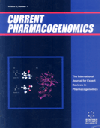- Home
- A-Z Publications
- Current Pharmacogenomics
- Previous Issues
- Volume 5, Issue 2, 2007
Current Pharmacogenomics - Volume 5, Issue 2, 2007
Volume 5, Issue 2, 2007
-
-
Cancer Pharmacogenomics: Germline DNA, Tumor DNA, or Both?
More LessAuthors: E. Cerri, A. Falcone and F. InnocentiThere is clear evidence that genetic information could be used to optimize treatment of cancer patients. The therapeutic index of chemotherapy could be enlarged by reducing the risk of toxicity, increasing the likelihood of tumor response, or both. Although germline DNA information has been already used to identify patients at high risk of toxicity, it is a matter of debate whether it could be also used to predict tumor resp Read More
-
-
-
Clinical Significance of Thiopurine S-Methyltransferase Gene Polymorphisms
More LessAuthors: Shu-Feng Zhou and Balram ChowbayThiopurine methyltransferase (TPMT) is an important enzyme that catalyzes the S-methylation of a series of thiopurine drugs, including 6-mercaptopurine (6-MP), thioguanine and azathiopurine (AZA), to generate inactive methylated metabolites. Thiopurine drugs are widely used to treat malignancies such as acute lymphoblastic leukemia, autoimmune diseases (e.g. inflammatory bowel disease and rheumatoid arthr Read More
-
-
-
Pharmacogenomics in Colorectal Cancer
More LessAuthors: F. Meriggi, B. Di Biasi, C. Caliolo and A. ZaniboniSeveral developments in the past few years have incrementally progressed the field and provided additional insights into the management of advanced colorectal cancer. The equivalence of several front-line regimens based on fluorouracil, capecitabine, oxaliplatin, irinotecan, bevacizumab, and cetuximab has provided opportunities for increased tailoring of therapies for individual patients. Nevertheless, some Read More
-
-
-
Genetics and the Mechanisms of Action of Inhaled Anesthetics
More LessAuthors: Louise M. Steele, Phil G. Morgan and Margaret M. SedenskyInhaled anesthetics have been used for more than a century, and they are currently administered to millions of patients each year. Although well understood in an empirical sense, their basic molecular mechanisms of action are still unknown. During the past two decades, a large amount of evidence has been presented that is most consistent with the hypothesis that inhaled anesthetics act at multiple sites. For example, gen Read More
-
-
-
Pharmacogenetics of Oxazaphosphorines and its Clinical Implications
More LessAuthors: Shu-Feng Zhou, Balram Chowbay and Charlie Changli XueThe oxazaphosphorines including cyclophosphamide and ifosfamide represent an important group of drugs because of their wide use as antitumor and immuno-modulating agents. This review highlights the effects of polymorphisms of genes involved in the action, distribution, metabolism, and transport of oxazaphosphorines on their pharmacokinetic variability and therapeutic outcomes. Emerging data indicate that polymorphi Read More
-
-
-
Structural and Functional Organization of miRNAs
More LessAuthors: E. Enerly, R. Sachidanandam, D. K. Pant, A. L. Borresen-Dale and V. N. KristensenUnderstanding human gene regulation is of pivotal importance in the field of genetics and genomics, including pharmacogenomics. Increasingly many described effects of natural genetic variation are exerted on the level of gene regulation. A novel mechanism of regulation of gene expression involving the so called the non coding microRNAs (miRNAs) has attracted a lot of attentions during the last years. MicroRNAs Read More
-
Most Read This Month
Article
content/journals/cpg
Journal
10
5
false
en


